German Army Artillery & Ordnance NCO's Dress Tunic
CATEGORY: Version
SKU: 20.GOR.02.01.01.01.03.002.000
Estimated market value:
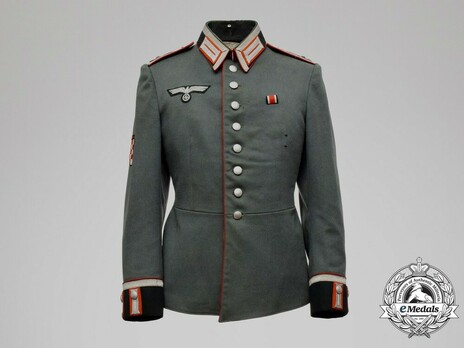
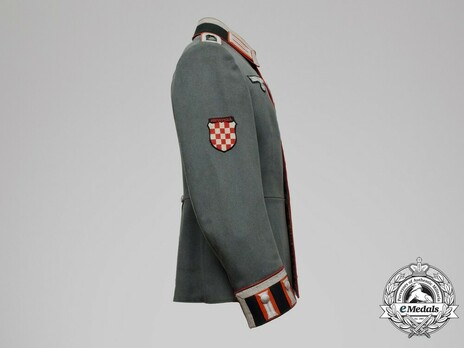
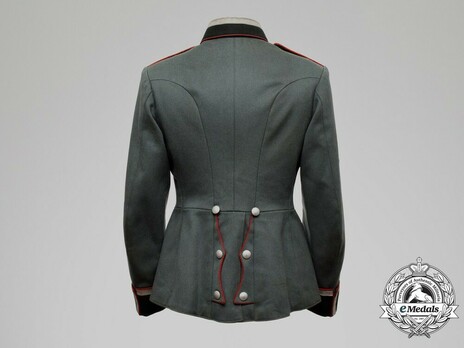
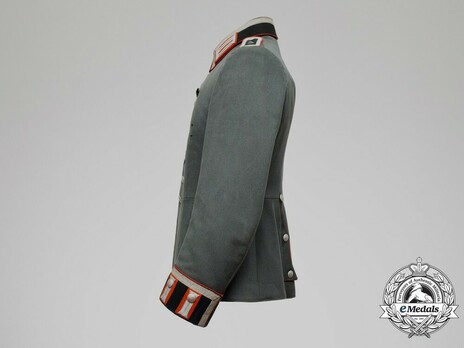
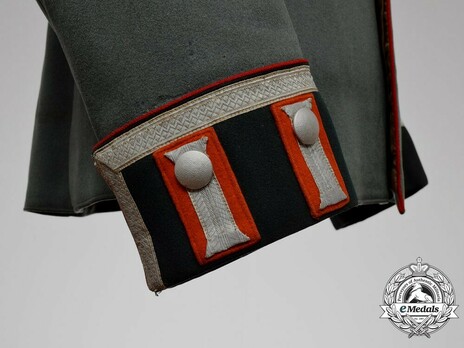
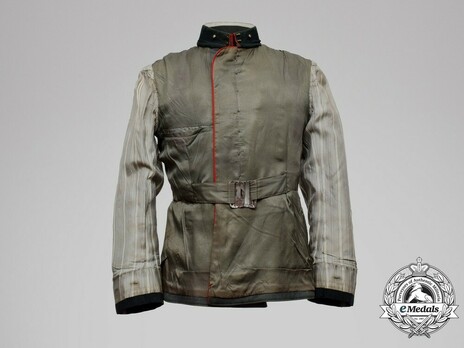
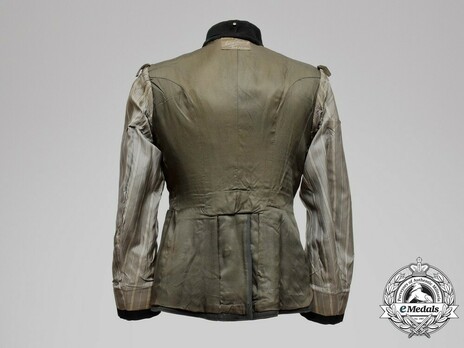
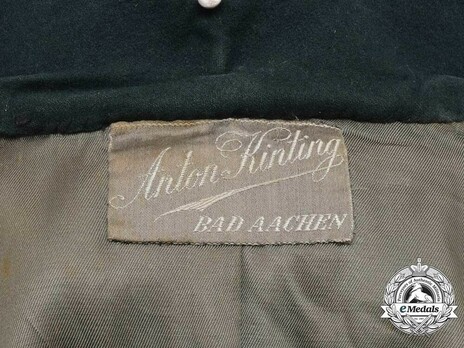
Estimated market value:
The tunic is fabricated from a fine Army green wool, while the contrasting collar is in hunter green wool. The shoulders are adorned with Sergeant's (Feldwebel) shoulder straps, each strap incorporating a 9 mm wide strip of fine silvered wire threading, sewn in place via white threading upon a hunter green wool upper, the edges trimmed in red cord piping indicating the branch to be Artillery, grayish-green wool underside, each strap with a gilt pip, secured in place by a silvered aluminum button with a pebbled upper and that is maker marked with a stylized "A" (F.W. Assmann & Söhne, Lüdenscheid) and marked "EXTRA FEIN" (Extra Fine) on the reverse. The inner edge of the collar is trimmed in a 9 mm wide strip of fine silvered wire threading, the outer edge trimmed in red cord piping, with both sides of the collar at the opening having Artillery Officer's collar tabs in fine silvered wire threading on red wool base sewn in place. There is a dual hook and eye at the opening of the collar, ensuring a snug fit at the neck line, complemented by three metal posts on the inside of the collar for placement of a protective liner. The right breast is enriched with a Army eagle insignia, in silvered bullion wire in various textures, interlaced with Army green threading giving definition to the wings, on a hunter green wool base. The left breast is adorned with an Iron Cross 2nd Class 1939 ribbon bar, with two vertically-aligned horizontal loops in black threading below the ribbon bar for an award that has since been lost to time. The front has a vertical row of eight silvered aluminum buttons with a pebbled uppers, each maker marked with a stylized "A" (F.W. Assmann & Söhne, Lüdenscheid) and marked "EXTRA FEIN" (Extra Fine) on the reverse, sewn in place on the right side, facing an equal number of reinforced button holes on the left side. Sewn in place on the upper right arm is a Croatian Volunteers Arm Shield in red, white and black embroidery, inscribed "HRVATSKA" ("Croatia" in Serbo-Croatian). The sleeves have French cuffs in hunter green wool, the upper edge trimmed in a 15 mm wide strip of fine silvered wire threading and red cord piping, each cuff with two rank patches in fine silvered wire threading on red wool base sewn in place, each patch with a silvered aluminum button with a pebbled upper. The rear of the tunic is single-vented, with scalloped flaps on either side of the venting, each flap with three silvered aluminum buttons with pebbled uppers and trimmed in red cord piping. The inside is lined in Army green rayon, with a green rayon loop in each armpit at the seam where the Army green rayon interior lining meets the sleeve lining, the sleeves lined in white rayon in a stripped pattern. Stitched to the lining on either side at the waist is an Army green rayon belt, the right end with a silvered metal clip, the left end with a silvered slotted receiver and when joined together, ensures a snug fit at the waist. In addition, there is a pocket sewn in place on the left breast, along with a reinforced slot below that opens into the exterior at the waist. The collar has an embroidered manufacturer's label inscribed "Anton Kinting BAD AACHEN" sewn in place. The tunic measures 420 mm across the shoulders and 620 mm in length overall, exhibiting bulging on the tips of the eagle insignia, the bullion remaining intact, wear present on the seam just above the reinforced slot on the exterior, the interior with moderate soiling from active use, with a hole on the bottom of the pocket on the left breast pocket, along with surface rust on the silvered metal clip and slotted receiver on the belt. As worn.
The Dress Tunic was introduced on June 29, 1935. It was worn by all members of the Heer during parades and ceremonial occasions, and as a walking-out dress.
The tunic is field-grey with a dark blue-green collar and dark blue-green cuff-facings, and has branch colour piping down the edge of the front overlap, down the front edge of the collar and around the collar base, on the upper edges of the cuff-facings, and down the two tunic flaps in the back.
The collar has a stand-up and fall-down part. There are eight silver-white metal buttons down the front. Three more buttons are attached to each of the two tunic flaps on the back, and one non-functional button to each of the four cuff-facing patches. General ranks had gold-coloured buttons.
The tunic has no pockets, except for two hidden pockets in the tunic tail.
Tunics for higher ranked soldiers are generally made from materials of superior quality. There are four different rank segments wearing slightly but distinctively different tunics: EMs (enlisted men), NCOs (non-commissioned officers), officers, and generals. General rank tunics can be identified not only by the gilt buttons, but also the ornate gilt embroideries on their cuff and collar patches. All other ranks had so-called Litzen (flat braid) on their cuff and collar patches. Those of officers were made of superior quality material and are more elaborate in design compared to the rather plain ones of EMs and NCOs. The difference between EM and NCO tunics lies in another type of flat braid, so-called Tresse (trimming), along the edges of the cuffs and collars, similar to those on NCO rank shoulder straps.
Tunic insignia, such as breast eagles, collar tabs, or shoulder boards will differ from rank to rank. For more information, see the appropriate entries in the Insignia subcategory.
Production of the dress tunic was discontinued with the outbreak of the war.
A special version was introduced on September 15, 1939 for members of the Infantry Regiment “Großdeutschland”. It has white piping and white metal buttons. The collar Litzen are elongated. Officer tunics have two collar Litzen, while those for EMs and NCOs only have one. There are three cuff-patches per cuff, which are of the so-called “French” cuff patterns.
Only very few jackets were ever given out due to the outbreak of the war, and it was never manufactured in great numbers.
Chaplains wore an Überrock (frock coat) in place of the Dress Tunic. For more information, see the Coats subcategory.
Branch colours on German Heer headgear was as follows:
Black was worn by Engineer units.
Black/White was worn by Panzer Engineers.
Copper Brown was worn by Motorcycle personnel.
Light Brown was worn by Signals units until 1936, and by Construction troops.
Carmine was worn by the Führer Staff, General Staff Officers, Staff Officers of the Supreme Command of the Army, and all Veterinary branches.
Bordeaux Red was worn by Smoke & Chemical personnel.
Wine Red was worn by Judicial officials.
Bright Red was worn by Generals, Artillery units, and Ordnance Officers (until 1944).
Rose or Pink was worn by all Armored units (including Panzer troops, and Schützen Brigade Staff).
Orange was worn by Recruiting personnel, Ordnance troops, Ordnance Officers (since 1944), and Field Gendarmerie units.
Bright yellow was worn by Cavalry units, and Light Division Staff.
Lemon yellow was worn by Signal units.
White was worn by Infantry units.
Light Grey was worn by Propaganda personnel.
Grey-Blue was worn by Sonderführer (Specialist Officers).
Violet was worn by Chaplains and Field Bishops.
Cornflower Blue was worn by Medical units, and Supply units.
Bright Blue was worn by Transport troops.
Bright Green was worn by Jäger and Mountain units.
Grass Green was worn by Panzer Grenadier units (Armored Infantry).
Dark Green was worn by Administrative personnel.

Comments
Sign in to comment and reply.


Scroll Top